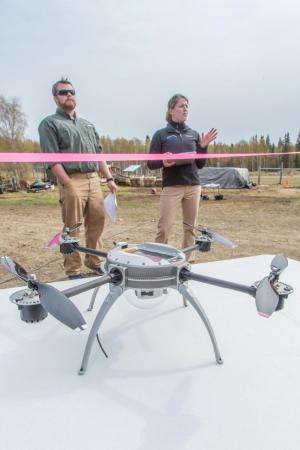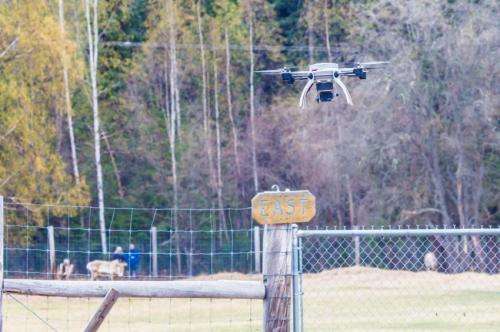UAF unmanned aircraft site conducts first test flight

The birds were noisier than the Aeryon Scout as the mini quadcopter whirred over the caribou lounging in the field at the Robert G. White Large Animal Research Station this morning.
The Scout climbed to 200 feet as a crowd of about 50 people silently watched its inaugural flight under the gray overcast sky at Fairbanks, Alaska.
It was a historic first for the University of Alaska Fairbanks, the Federal Aviation Administration and unmanned aircraft operations.
Michael Huerta, FAA administrator, announced this morning in Anchorage that FAA had granted operational status to the Pan-Pacific Unmanned Aircraft Systems Test Range Complex. Minutes after the announcement, Scout operator Mike Cook took the aircraft to the sky in Fairbanks, the first test mission flight among the six FAA-chosen test sites.
Cook's flight over the caribou was part of a research project to see if the aircraft can be used to observe and collect data about large animals without disturbing them.
"It was picture perfect," said Jay Skaggs, FAA's safety inspector based in Anchorage. "He made aviation history."
UAF's achievement today capped years of work with federal, state and private entities, said UAF Chancellor Brian Rogers.
"Our presence here illustrates an important point about unmanned aircraft work," Rogers said. "It's not simply about the technology, but rather about the application of that technology to real-world needs."

The Pan-Pacific test range became operational with the issuance of FAA's Certificate of Authorization. It was the second of the six recently named test sites to receive one.
The range was established last year to help the FAA develop regulations and certifications for unmanned aircraft operators and equipment. The goal is to integrate them into the National Airspace System.
The range is managed by the Alaska Center for Unmanned Aircraft Systems Integration, which is one of 15 units at UAF's Geophysical Institute.
"The test site program is forging ahead just as we expected," said Huerta during the announcement in Anchorage. "The University of Alaska Fairbanks program is important because it includes a diverse set of test site range locations in seven climatic zones, so it will give us a wealth of data to help develop appropriate safety regulations and standards."
Provided by University of Alaska Fairbanks



















